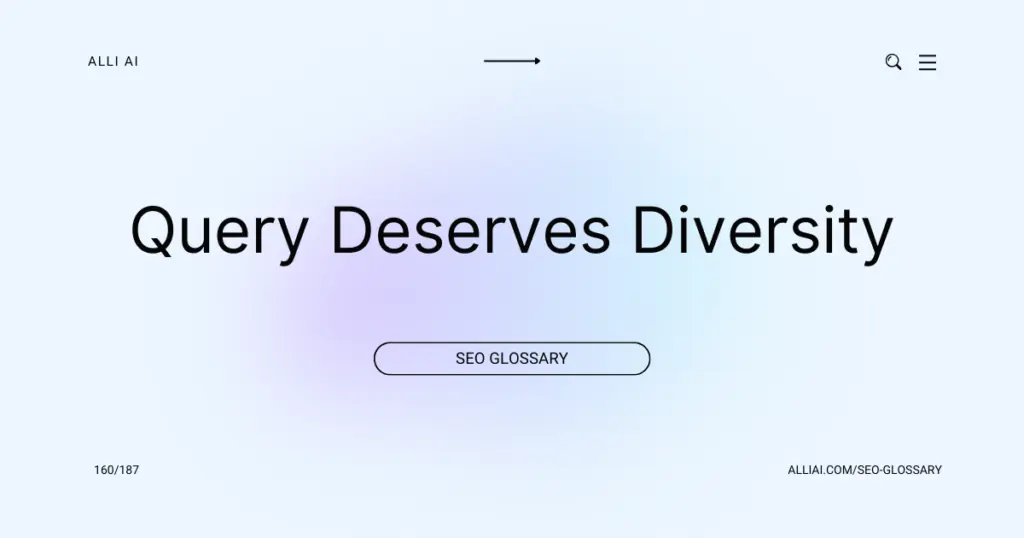What Does Query Deserves Diversity (QDD) Mean?
Query Deserves Diversity (QDD) is a concept used in search engine optimization (SEO) that refers to the adjustment search engines make to display a wide range of results for certain queries where users might be looking for different types of information. This means that if the intent of a search query can vary significantly among different users, the search engine will try to provide a diverse set of results to cater to these varying needs, ensuring that different aspects or angles of the query are addressed in the results shown.
Where Does Query Deserves Diversity (QDD) Fit Into The Broader SEO Landscape?
Query Deserves Diversity (QDD) is a concept used by search engines to enhance search results for ambiguous or multi-faceted queries. In SEO, QDD impacts strategy by requiring content creators to consider multiple interpretations or subtopics of a query to capture varying user intent. Incorporating varied content types (text, video, images), addressing different aspects or meanings of a query, and using a diversity of keywords can optimize visibility across these varied results. QDD also encourages the development of comprehensive content that serves varied user needs, supporting long-tail keyword strategies and improving engagement metrics, factors that are beneficial for SEO.
Real Life Analogies or Metaphors to Explain Query Deserves Diversity (QDD)
1. Ice Cream Shop: Imagine walking into an ice cream shop wanting to try something new. You ask for a popular flavor, and instead of just giving you chocolate and vanilla, the server offers you a sampler of unique flavors mixed in, like raspberry chocolate chip or mango sorbet. QDD works similarly; when you search a popular term, it presents you with a variety of content—not just the most common answers—to enrich your experience and meet diverse tastes.
2. Music Festival: Picture a music festival lineup designed to appeal to everyone. Instead of only featuring rock bands, the organizer includes jazz, hip-hop, and country artists. By doing this, they cater to a broader audience’s interests. QDD in search engines parallels this; it ensures that for a given query, the search results include a mix of perspectives or content types, making sure there’s something for everyone.
3. Library Shelves: Think of a librarian organizing books on a shelf. If someone asks for a book on gardening, the librarian doesn’t just show books on vegetable gardening; they also include books on floral gardening, organic practices, and balcony gardens. QDD in a search engine mirrors this approach, diversifying the results so that it covers a range of subtopics or viewpoints around a single query.
4. TV Remote: Using a TV remote to browse channels is a lot like using QDD. You might press the guide button looking for news, but instead of just showing the most watched channel, the TV displays a variety of news sources, including international news, local news, and weather forecasts. This variety ensures you have a richer selection to choose from, tailored to different preferences and needs.
5. Teacher in a Classroom: Consider a teacher addressing students who have asked about climate change. Instead of focusing solely on the scientific explanations, the teacher provides a range of resources: scientific articles, economic impacts, political debates, and activist documentaries. Like QDD, this approach offers students multiple angles on the same topic, enriching their understanding and engaging their diverse interests.
Each metaphor highlights how QDD aims to provide a richer, more varied experience by presenting multiple viewpoints or types of content in response to a query, thus catering to a wider range of user needs and interests.
How the Query Deserves Diversity (QDD) Functions or is Implemented?
The Query Deserves Diversity (QDD) mechanism is a part of search engine algorithms designed to handle ambiguous or multi-faceted queries by delivering a diverse set of results that cater to different user intents. Here’s how it generally functions:
1. Query Analysis: The search engine identifies whether a query is ambiguous or could have multiple interpretations or intents.
2. Intent Clustering: Generates clusters of possible intents behind the query. This can involve analyzing historical data, related searches, and user interaction data to categorize possible meanings or subtopics relevant to the query.
3. Diverse Result Selection: For each identified intent cluster, the algorithm selects representative results. These results are chosen to cover as many potential interpretations of the query as effectively as possible.
4. Ranking Adjustment: The search engine may adjust the ranking of the results to ensure that top results are not only the most relevant for the most likely intent but also provide coverage for less common intents.
5. Result Merging: Finally, the chosen results for each intent are merged into a single results page. The aim is to maintain a balance where the most common user intents are more prominently represented while still including results for less common intents.
6. Evaluation and Feedback: The search engine monitors user interaction with the diverse set of results (clicks, time on page, bounce rates) to evaluate the effectiveness of the diversity adjustment and refine the process for better accuracy in future queries.
Through this process, QDD ensures that the search results page is equipped to satisfy a broader range of user needs, particularly in cases where a single query might lead to multiple search intents.
Impact Query Deserves Diversity (QDD) has on SEO
Query Deserves Diversity (QDD) impacts a website’s SEO by adjusting the search results to include a broader range of content types and perspectives for ambiguous or broad queries. This means that websites providing unique, diverse content might see better visibility in these scenarios. For rankings, QDD can disrupt traditional positions since it may cause results to fluctuate based on the diversity of content deemed relevant by search algorithms. For user experience, QDD enhances satisfaction by delivering varied content that addresses different aspects of a query, which can help in attracting a wider audience. Websites aligned with QDD principles are likely to benefit from increased engagement and reduced bounce rates due to more accurately meeting user intent.
SEO Best Practices For Query Deserves Diversity (QDD)
1. Analyze Search Intent: Determine the various intents behind the query, such as informational, transactional, navigational, or a combination.
2. Research Keywords: Identify a diverse set of keywords related to the query, considering synonyms, related terms, and both long and short-tail keywords.
3. Create Varied Content Types: Develop multiple content formats such as blog posts, videos, infographics, and product pages to cater to different user intents.
4. Use Unique Angles and Perspectives: Craft content that addresses the query from multiple angles. Include unique insights, data, case studies, and expert opinions.
5. Optimize for Relevance and Authority: Ensure that all content is SEO-optimized with relevant keywords, meta tags, and high-quality, authoritative links.
6. Enhance User Experience: Design your website to be user-friendly, with fast load times, easy navigation, and mobile compatibility.
7. Incorporate Multimedia Elements: Leverage images, videos, and audios to make the content richer and more engaging.
8. Update Regularly: Keep your content fresh and up-to-date to cater to evolving user interests and queries.
9. Monitor Performance: Use analytics tools to track how each type of content performs and make adjustments to improve visibility across various user intents.
10. Build External Links: Gain backlinks from various authoritative sites in different niches to enhance content credibility and diversity in SERP rankings.
Common Mistakes To Avoid
1. Ignoring User Intent Variability: Failing to recognize the range of intents behind queries can lead to creating content that doesn’t satisfy all potential user needs. To avoid this, analyze search results for key queries to discern different user intents and develop diverse content that addresses these variations.
2. Over-Optimizing for a Single Intent: Concentrating too much on one particular interpretation of a query can lead to neglecting others that might be equally or more relevant to a segment of the audience. Combat this by incorporating multiple aspects or perspectives related to the query in your content strategy.
3. Neglecting Long-Tail Keywords: Long-tail keywords often reveal specific user intents. Overlooking these can result in missing out on less competitive, diverse search traffic opportunities. Ensure your keyword research is thorough and includes long-tail variations to capture a broader spectrum of user intents.
4. Overuse of Keyword Targeting: Excessive use of the same keywords can make content feel forced and unnatural, potentially lowering user engagement. Focus on semantic richness and topic coverage rather than repetitive keyword use to align with QDD principles.
5. Lack of Content Variety: Relying on a single type of content (e.g., all blog posts or all videos) may not adequately address diverse user needs. Include various content formats like videos, infographics, podcasts, and articles to cater to different preferences and consumption habits.
6. Static Content Strategy: Not updating content to reflect current trends or new interpretations of queries can make your website feel outdated. Regularly review and update your content to stay relevant and appealing to a diverse audience.
7. Disregarding SERP Analysis: Skipping the analysis of search engine results pages (SERPs) for key queries can lead to inaccurate assumptions about what kinds of diversity are needed. Analyze SERPs regularly to identify the types and range of content being rewarded with visibility.
8. Ignoring Regional Variations: Different regions may have different ways of interpreting the same query. Ensure that your content is tailored to reflect regional nuances or consider creating region-specific pages if applicable.
9. Failure to Monitor Performance: Without tracking how diverse content performs, you won’t be able to adjust strategies effectively. Implement a robust monitoring system to track engagement and success across different content types and intents.
10. Not Using Feedback Mechanisms: Neglecting user feedback on your content can lead to missed opportunities for improvement and alignment with diverse user needs. Incorporate feedback mechanisms and actively solicit user responses to refine and validate your content approach.






